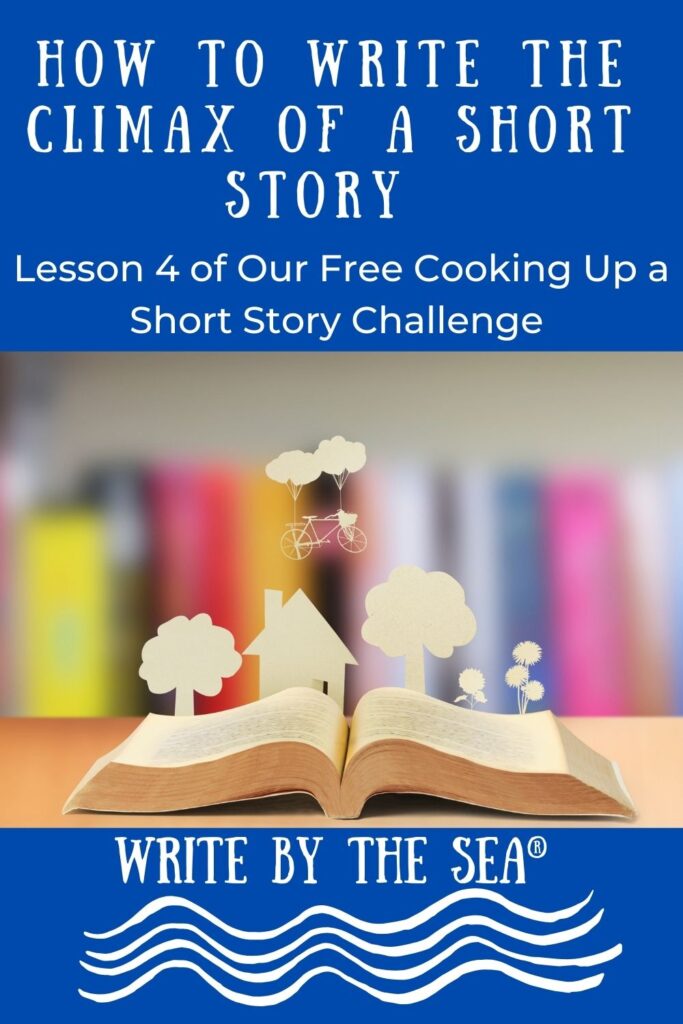by Suzanne Lieurance

In this week’s lesson of our Cooking Up a Short Story Challenge, you’ll learn how to write the climax of your story.
Listen to this week’s audio as you read the rest of this post:
How to Cook Up an Exciting Climax and a Satisfying Resolution to Your Short Story
Up to this point, you’ve been creating rising action for your story to keep readers reading because they’ve wanted to find out what happens next.
This rising action now leads to the climax, or the most exciting part, of your short story.
The climax is also the point in the story where the main story problem is solved, or at least resolved, because of some action the main character takes.
In other words, it is a point of confrontation and realization.
For example, if you’re writing a mystery, maybe a series of clues have been leading your sleuth to the person who committed the crime in your story.
But when your protagonist finally meets or confronts this person, it’s a highly tense scene.
Perhaps your sleuth falls under the clutches of this person and must somehow get away from him or her.
If you’re writing a romance, maybe this is the point where your two main characters finally get together to live happily ever after.
Here are some tips for writing an exciting climax:
1. Make use of the same ingredients you’ve used up to this point in your story—action, dialogue, and sensory details, so the climatic scene in your story really comes to life for your readers.
If you’re writing a romance, this is where emotions can be a big part of your story.
Make your readers feel what your main characters are feeling when they come together.
If you’re writing a mystery, have feelers feel the danger your sleuth faces as he/she is finally uncovering who is responsible for the crime in your story.
2. Be sure your main character is the one who solves the story problem in your climax.
Resist the urge to have someone else step forward and save the day for your main character.
This is true even in romance, where you might think the hero comes forward and rescues the heroine in some way.
Even if he does rescue her, have her do something that makes that rescue possible.
3. Have your most exciting scene (the climax) happen in the final page or pages of your story.
You don’t want much to happen AFTER this scene, just a short wrap up.
In fact, if you can end your story with the climax, yet make it evident what happens to them after this scene, so much the better.
But, if this isn’t possible for some reason, include a short wrap up scene after the climax that ties together any loose ends so the readers is left feeling satisfied.
Remember—the climax should come about because of everything that has come before it—not just the action, but the way you’ve developed your characters, their motives, etc.
4. What will be the take away point of your story – the theme?
Generally, you want your main character(s) to have changed or grown somehow after this climatic moment, even if he/she isn’t able to solve the story problem.
In fact, quite often, at the end of a story the main character finally figures out that what he thought he wanted, he didn’t really want at all.
Be sure your main character changes or grows as a result of your climatic scene and you have some take away point, or theme, to your story.
One final note: After you’ve finished writing the climax and the resolution to your story, now all you have is your 1st draft.
That means it’s time to start revising your story—polishing and polishing it until it’s the best it can be (or at least the best you can make it right now).
Later this week, I’ll have another post with some revising and editing tips to help you polish your short story.
All the short story challenges:
Don’t forget to join our mailing list.
Just fill in your name and email address, below:
More at Pinterest.







One Comment
Comments are closed.